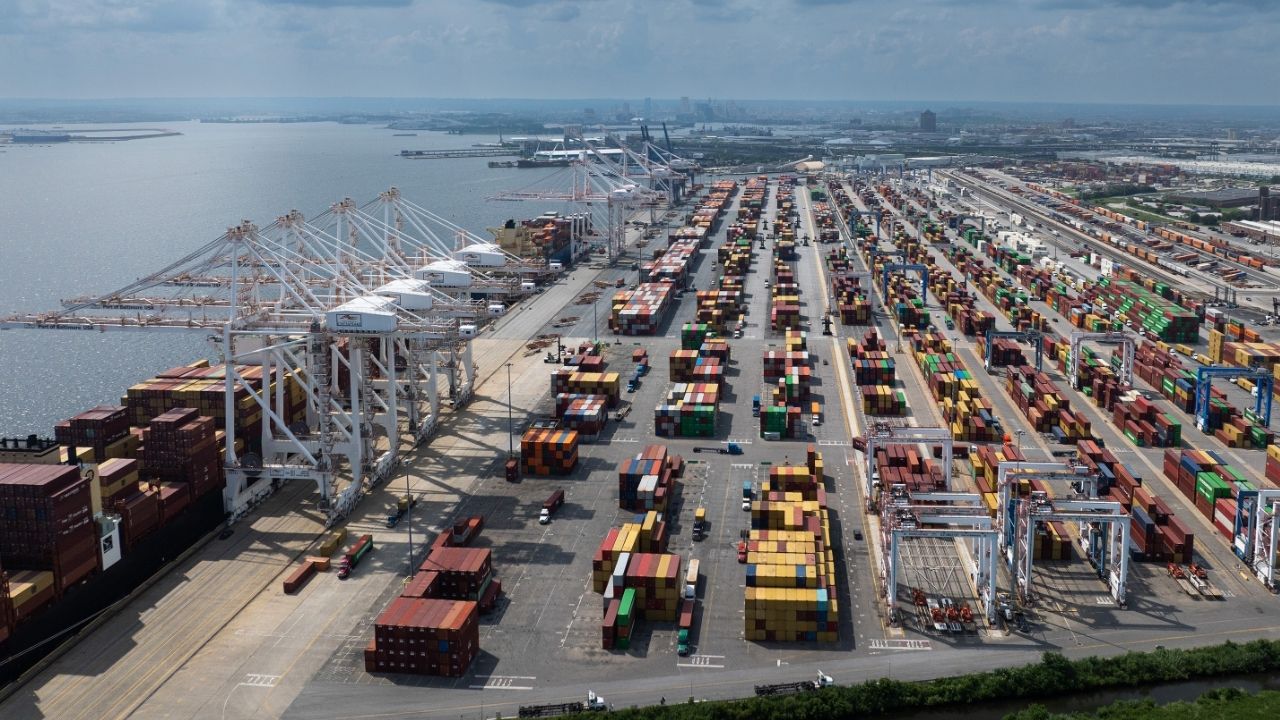Containers line the Seagirt Marine Terminal at the Port of Baltimore, Md., June 30, 2025. The steep tariffs President Trump issued in August led to a significant contraction in imports and the trade deficit, newly released data shows. (Alyssa Schukar/The New York Times)
Share
|
Getting your Trinity Audio player ready...
|
WASHINGTON — President Donald Trump’s sweeping tariffs took a toll on trade in August, as imports of goods and services dropped 5.1%, to $340.4 billion, after taxes on exports from roughly 90 countries went into effect Aug. 7, newly released data from the Commerce Department showed Wednesday.
The data, which incorporates less than a month of Trump’s new tariffs, illustrates how the sharp increase in trade taxes has scrambled life for international business. U.S. firms clamped down on purchases of foreign machinery, industrial supplies, pharmaceutical ingredients and telecom equipment as tariffs went into effect in August, after months of stockpiling that had filled their storerooms and warehouses.
U.S. goods exports also fell in August, shrinking $500 million to $179 billion as the rest of the world bought fewer American consumer goods, cars and car parts, and gold. That was offset by an increase in exports of U.S. services, including travel.
Because of the sharp fall in imports, the U.S. trade deficit in goods and services for the month also dropped sharply, shrinking nearly 24%, to $59.6 billion, compared with July.
The data, which is compiled by the U.S. Census Bureau, had been delayed by more than a month because of the government shutdown. It illustrated the volatility that businesses have contended with this year, as Trump introduced what is effectively a new trading system for the United States.
The president announced global double-digit tariffs in April on what he called “Liberation Day,” saying that the previous system had cheated the United States and cost Americans jobs and money. While his tariffs briefly went into effect, they were then largely paused for four months as the administration tried to strike deals with trading partners.
On Aug. 7, the tariffs again went into effect, with a 15% rate on goods from Bolivia, Ecuador and Nigeria; 20% on Taiwanese products; and 50% on Brazilian exports.
Altogether, they brought the U.S. effective tariff rate to more than 18%, the highest level since 1934, according to the Budget Lab at Yale.
U.S. imports and exports had risen in July, as companies that depend on goods from other countries tried to get their shipments in before those tariffs went into effect. In August, trade then dropped, as American businesses imported fewer industrial supplies, food and beverages, and machinery, according to an analysis by Moody’s Analytics.
The sharp drop in the U.S. trade deficit in recent months might appear to have accomplished one of Trump’s goals. Although many economists still disagree with the idea, the president has often looked at the trade deficit as a sign of weakness for the U.S. economy. He has argued that the United States should make more of its own goods.
Stepping back, however, the recent drop in the trade deficit looks so steep largely because the threat of Trump’s tariffs massively increased imports and the trade deficit earlier this year. After Trump’s election, the U.S. trade deficit spiked as companies rushed to try to game the system and bring in goods ahead of tariffs coming into effect. Those shipments started to drop after April, when the president announced his global tariffs.
Tariffs are likely to continue to weigh on imports in the months to come, but Trump will have a long way to go to accomplish his goal. Because of the rush of imports earlier this year, the U.S. goods and services deficit is up a hefty 25% in the year-to-date through August, compared with the same period in 2024.
The stockpiling from businesses has also been a significant factor in mitigating the economic impact of the tariffs. For months, U.S. companies had held off on increasing their prices as they worked through old inventory.
But as time goes on and that inventory lessens, more companies have begun to pass the burden of tariffs on to American consumers in the form of higher prices. That has weighed on Trump’s popularity and presented a conundrum for a president who campaigned on his ability to keep costs low for average American families.
This month, Democrats won elections around the country in large part by harnessing worries about the cost of living. Last week, the Trump administration introduced new tariff exemptions in an effort to lower some food prices. It remains to be seen if concerns about high consumer costs will encourage the administration to further back down on its tariffs.
Many of the president’s tariffs, including those he issued in early August, could also be undermined by a challenge at the Supreme Court. The court is weighing whether Trump exceeded his legal authority with those tariffs, and it could curtail or strike them down in the coming weeks or months.
Even so, the president has other legal authorities he can use and is likely to announce new measures to replace at least some of them.
—
This article originally appeared in The New York Times.
By Ana Swanson/Alyssa Schukar
c. 2025 The New York Times Company




















